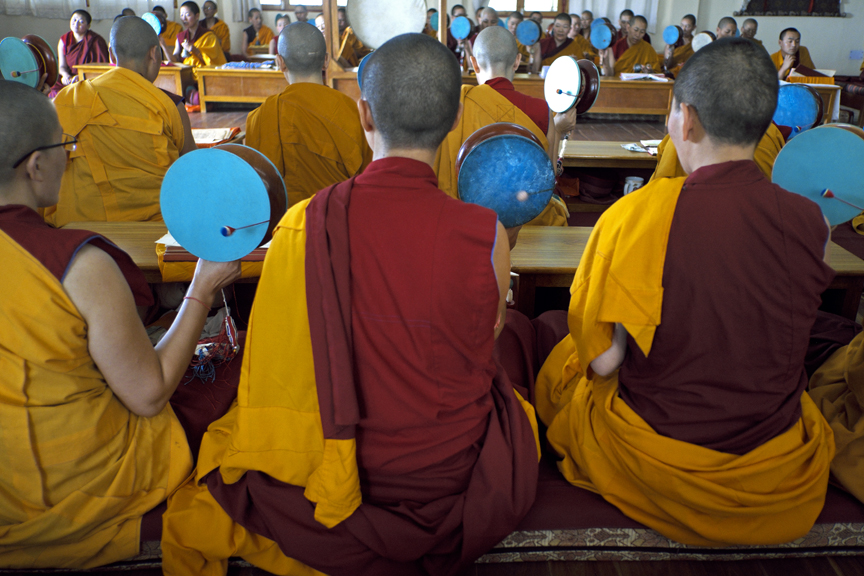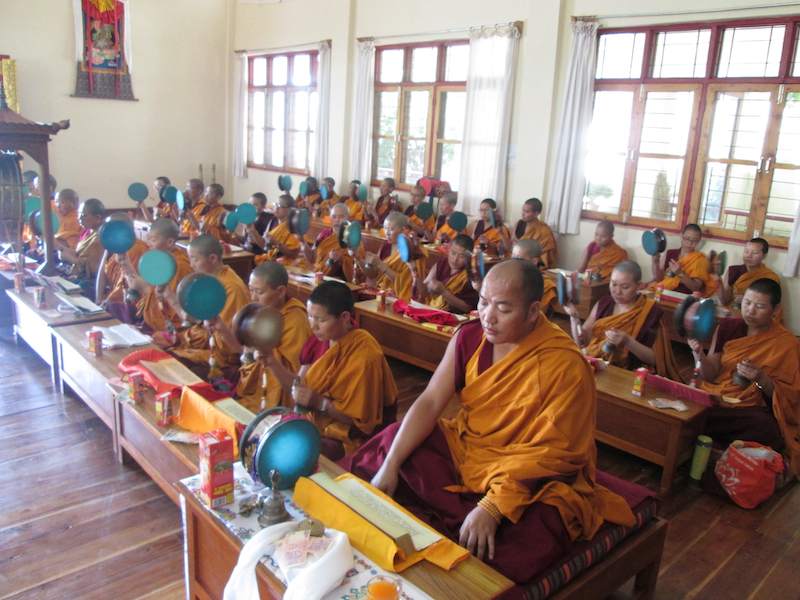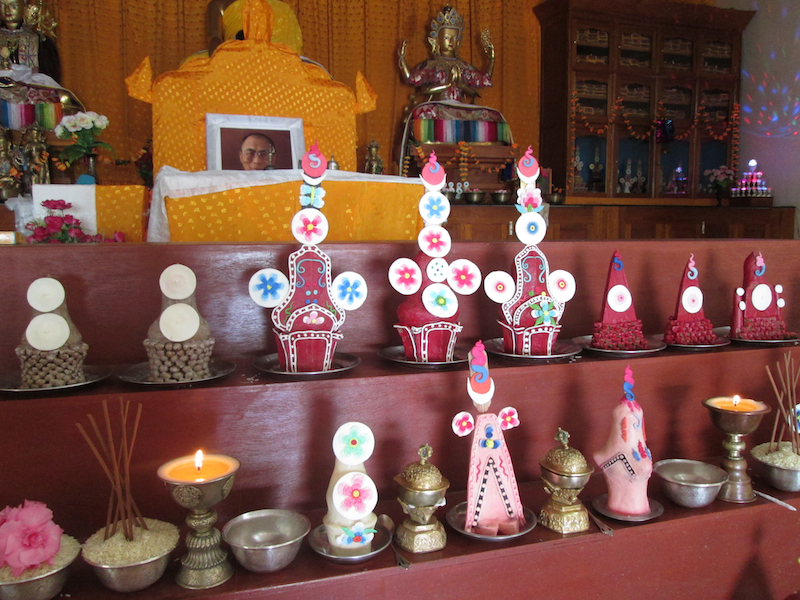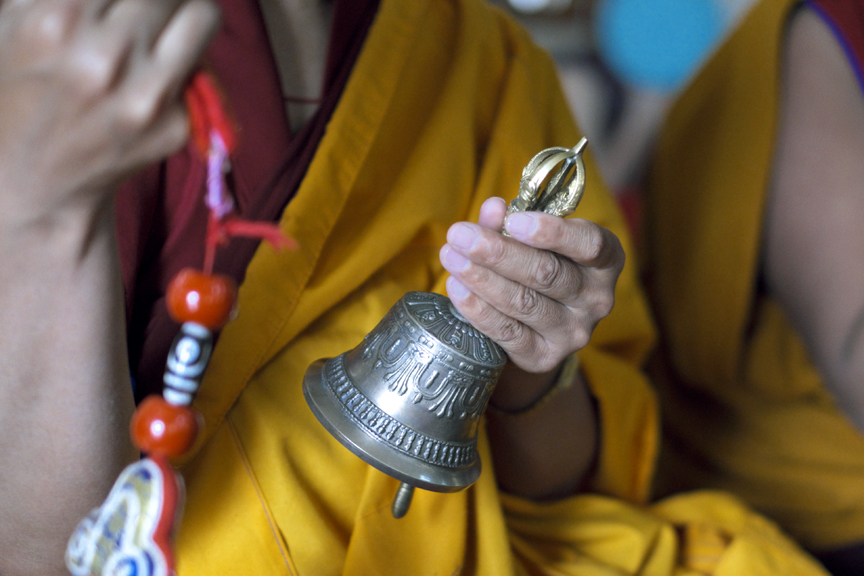Every Sunday night, the nuns of Shugsep Nunnery and Institute in northern India practice a special ritual called Chöd (pronounced chö) also known as “The Beggars Offering” or “Cutting Through the Ego.”
Chöd, which literally means “cutting through”, is a spiritual practice that aims at cutting through the hindrances or obscurations of self-cherishing thought and ignorance, the greatest obstacles on the path to enlightenment.
The tantric practice of Chöd originated in India but was greatly developed in Tibet by the great female practitioner or yogini of the 11th century, Machig Labdrön. She originated a new lineage of the practice that is the only tantric Buddhist practice that was introduced back to India from Tibet.
Shugsep Jetsun Rinpoche (1852–1953), Abbess of Shugsep Nunnery in Tibet, was also an exemplary practitioner of Chöd and was a recognized incarnation of Machig Labdrön.
In the Chöd ritual, practitioners visualize symbolically offering their own bodies, for the sake of others, as a tantric feast to sentient beings. This is a brave way to exchange oneself for others and develop compassion, and a quick method to realize emptiness.
During the ritual, the nuns immerse themselves in a combination of chanting, music, prayer and visualizations. It is said that by engaging every aspect of one’s being this practice can effect a “powerful transformation of the interior landscape.”
While reciting the Chöd rite the nuns are accompanied by the sound of several Tibetan instruments: the damaru or hand drum, the kangling, a reed instrument, and the Chöd drum, which is larger than the hand drum.
There are both simple and elaborate forms of the practice. In the elaborate form, the Chöd practice is accompanied by offerings of ritual barley cakes, fruit, and other foods, and also involves a special Chöd dance performed as an offering to the spiritual teachers, deities, dakinis, and dharma protectors.
This special dance is sometimes performed during funeral processions and involves visualizations of dakinis leading the spirit of the deceased person to a pure realm. This ritual is felt to remove the inner, outer, and secret obstacles of the deceased person.

About Shugsep Nunnery
Shugsep Nunnery and Institute in northern India is one of the two nunneries built and fully supported by the Tibetan Nuns Project. Many of the nuns now in India came from the original Shugsep Nunnery in Tibet. They had been expelled by Chinese authorities for their political activities on behalf of Tibet and escaped over the Himalayas to practice their religion in India.
Shugsep Nunnery was re-established in India in 1992 and the newly built nunnery was inaugurated by His Holiness the Dalai Lama on December 7 2010.
This important Nyingma nunnery traces its rituals and practice to some of the most illustrious female practitioners in Tibetan history. In the 20th century, Shugsep Nunnery in Tibet was home to one of the most famous teachers of her time, Shugsep Jetsunma.
Following the Chinese Cultural Revolution in 1959, the nuns were forced to leave Shugsep Nunnery in Tibet and the nunnery was completely destroyed. Although the nunnery was partially rebuilt in the 1980s by the nuns themselves, the nuns faced frequent harassment by Chinese authorities.

Tashi delai thank you for turning the wheel of dharma and preserving the authentic teachings of jetsun ma!
Thank you
My thank you is for tnp.org as they allows me to learn a lots
I chose to do this ritual for my religion project in school and it was so eye opening to learn about this amazing ritual from a different religion and culture than my own. When I read the part about the nuns being expelled from China I was disgusted that the Chinese government could be so cruel towards someone different than them! Maybe I feel this way because I live in America so I was born with those freedoms but still. Love you all and continue your beautiful and spiritual ritual!
HelloIs it possible to ask you the complete text in tibetan of the Chod please?
thank you very very much for your anwer
Dear Viviane, I’m afraid that we don’t have access to that here, but this link may be helpful to you: http://www.rinpoche.com/teachings/chod.htm
བཀྲ་ཤིས་བདེ་ལེགས
“Above all, be at ease, be as natural and spacious as possible. Slip quietly out of the noose of your habitual anxious self, release all grasping, and relax into your true nature. Think of your ordinary emotional, thought-ridden self as a block of ice or a slab of butter left out in the sun. If you are feeling hard and cold, let this aggression melt away in the sunlight of your meditation. Let peace work on you and enable you to gather your scattered mind into the mindfulness of Calm Abiding, and awaken in you the awareness and insight of Clear Seeing. And you will find all your negativity disarmed, your aggression dissolved, and your confusion evaporating slowly like mist into the vast and stainless sky of your absolute nature.”
― Sogyal Rinpoche, The Tibetan Book of Living and Dying